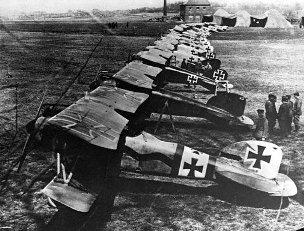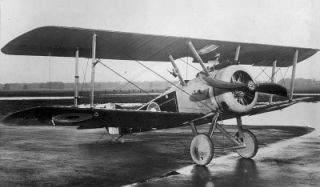How Did Airplane Use Change As World War I Progressed?
History >> Globe State of war I
World War I
Aviation and Aircraft of WWI
World War I was the first major state of war where airplanes were used as a significant function of the military. The airplane was invented by the Wright Brothers in 1903, just 11 years earlier the first of World War I. When the state of war first began, aircraft played a small office in warfare, merely, by the end of the state of war, the air force had become an of import co-operative of the armed forces. 
German Albatros by a High german official photographer
German fighter planes lined upwards for takeoff
Reconnaissance
The first use of airplanes in World War I was for reconnaissance. The airplanes would wing higher up the battlefield and determine the enemy's movements and position. I of the get-go major contributions of airplanes in the war was at the First Battle of the Marne where Centrolineal reconnaissance planes spotted a gap in the German lines. The Allies attacked this gap and were able to split the German armies and bulldoze them back.
Bombings
As the war progressed, both sides began to apply shipping to driblet bombs on strategic enemy locations. The outset planes used for bombings could only carry small bombs and were very vulnerable to attack from the ground. By the end of the war, faster long-range bombers were built that could carry a much larger weight of bombs.
Machine Guns and Dogfights
With more than planes taking to the skies, enemy pilots began to fight each other in the air. At first, they tried throwing grenades at each other or shooting with rifles and pistols. This didn't work very well.
Pilots soon found that the best manner to shoot downward an enemy airplane was with a mounted machine gun. Withal, if the machine gun was mounted at the front of the aeroplane, the propeller would get in the way of the bullets. An invention chosen an "interrupter" was invented by the Germans that allowed the motorcar gun to be synchronized with the propeller. Soon all fighter planes used this invention.
With mounted machine guns, pilots often fought enemy pilots in the air. These fights in the air were called dogfights. The best of the pilots became famous and were nicknamed "aces."

The British Sopwith Camel fighter plane
Types of WWI Aircraft
Each side used a number of different airplanes throughout the war. Constant improvements were made in the design of the planes as the state of war progressed.
- Bristol Type 22 - British 2-seater fighter plane.
- Fokker Eindecker - Single-seat German fighter airplane. The Fokker was perhaps the most famous fighter plane during WWI equally it introduced the synchronized auto gun and provided Deutschland with air superiority for a period of fourth dimension during the war.
- Siemens-Schuckert - Unmarried-seat German fighter plane.
- Sopwith Camel - Single-seat British fighter plane.
- Handley Page 0/400 - Long range British bomber.
- Gotha One thousand V - Long range German bomber.
When the state of war first started, the planes were just regular planes without whatever armed forces markings. Unfortunately, ground troops would try to shoot down any plane they saw and sometimes shot down their own plane. Somewhen, countries began to marker their planes under the wing and then that they could be identified from the ground. Hither are some of the markings used during the war.
AirshipsFloating airships were also used during Globe State of war I for both reconnaissance and bombings. Federal republic of germany, France, and Italy all used airships. The Germans made the well-nigh utilize of airships, using them extensively in bombing campaigns over United kingdom. Airships were frequently used in naval battles likewise.
Famous WWI Fighter Pilots
The all-time fighter pilots in World War I were chosen "aces." Every time a fighter pilot shot down some other aeroplane, he claimed a "victory." Aces kept runway of their victories and became heroes in their corresponding countries. Here are a few of the well-nigh busy and famous fighter pilots.
- Manfred von Richthofen: German, 80 victories. Also known as the Red Businesswoman.
- Ernst Udet: German, 62 victories. Famous for using a parachute to survive getting shot down.
- Werner Voss: German, 48 victories.
- Edward Mannock: British, 73 victories. The near victories of any British ace.
- William A. Bishop: Canadian, 72 victories.
- Rene Fonck: French, 75 victories. The most victories of any Centrolineal ace.
- Georges Guynemer: French, 53 victories.
- Eddie Rickenbacker: American, 26 victories. The about victories of any American ace.
- The Fokker Eindecker airplane became known equally the Fokker Scourge when information technology was kickoff used against the Allies by the Germans.
- The Germans called their airships Zeppelin'southward after their builder Count Ferdinand von Zeppelin.
- The first aircraft carriers were constructed during World War I. The get-go time a carrier-based aeroplane attacked a land target was in July of 1918 near the end of the state of war.
- The planes used in WWI were much slower than the planes used today. Pinnacle speeds were ordinarily just over 100 miles per hr. The Handley Page bomber topped out at near 97 miles per hour.
Have a x question quiz about this page.
Learn More well-nigh Globe War I:
Works CitedHistory >> Earth War I
How Did Airplane Use Change As World War I Progressed?,
Source: https://www.ducksters.com/history/world_war_i/aviation_and_aircraft_of_ww1.php
Posted by: martinezwitund.blogspot.com


0 Response to "How Did Airplane Use Change As World War I Progressed?"
Post a Comment